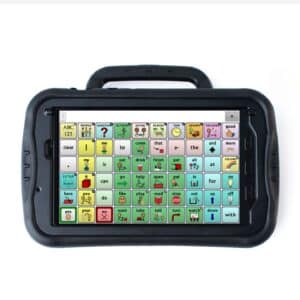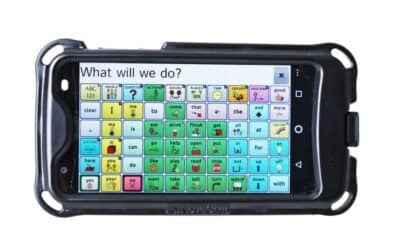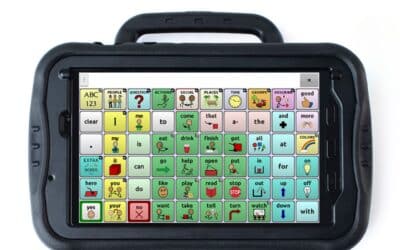Communication is fundamental to human interaction. For children who face challenges with spoken communication, Augmentative and Alternative Communication (AAC) offers a powerful pathway to develop their language and help them express their needs, wants, feelings, and ideas. As parents, understanding and incorporating AAC into daily life is essential to maximize your child’s use of these methods and tools. This article will guide you through twenty ways to use AAC at home and highlight five things to remember in the process.
What is Augmentative and Alternative Communication?
Augmentative and Alternative Communication (AAC) refers to the many ways individuals can communicate either temporarily or permanently to supplement or replace their spoken language. AAC includes unaided methods to communicate that use only the body. Examples of unaided AAC are facial expressions, gestures, sign language, and body movements. AAC also includes aided ways to communicate. Aided AAC requires external tools to support communication such as pictures, communication boards and notebooks, and a wide range of electronic devices and software.

The Importance of Modeling in AAC
Modeling in the context of AAC means demonstrating to the child how to use AAC. Just as toddlers watch and imitate adults talking, children learning to use AAC need to see their devices or systems being used in real-life contexts by others. The more parents model the use of AAC, the more a child understands its utility and becomes motivated to use it.
Real-life Example: If a child has a speech-generating device, a parent might press the button for “hungry” or to make a food choice or food-related comments during mealtimes. Similarly, at bedtime it can be used to select a book choice, participate in book sharing, and/or to indicate “sleepy.” This demonstrates for the child how to express those desires and feelings. Parents should always model spoken language while using AAC.

Setting Up for Success: Integrating AAC in Daily Routines
To ensure successful use of both unaided and aided AAC, it’s important to weave them into your child’s daily life. Each of these ideas can be adapted to fit your child’s developmental and communication levels.
Twenty Creative Ways to Use AAC at Home
- Mealtimes:
- Label foods with signs, pictures or symbols.
- Use AAC to make a choice to indicate food preferences: “Do you want apple or banana?”
- Practice using signs, gestures, and/or pictures to indicate mealtime related words ush as, “more” or “finished”.
- Play Time:
- Use pictures, symbols or signs to label and comment about different toys.
- Incorporate a “choice board” to pick toys, games, or activities.
- Have a communication board dedicated to play activities.
- Bath Time:
- Incorporate signs, pictures or symbols such as, “water”, “soap”, “duck,” or “towel” into the bath routine.
- Use pictures or symbols to sequence the bath routine.
- Discuss feelings related to bath like “warm”, “cold”, “fun,” and “splash.”
- Reading:
- Use AAC to name and describe illustrations, discuss characters, actions, or plot.
- Use AAC to highlight key story events.
- Ask predictive questions: “What will happen next?” Model the answers to questions if child cannot yet give answer.
- Dressing:
- Label clothing items and use AAC to request and describe clothing choices.
- Use AAC to discuss weather-appropriate clothing.
- Sequence the dressing routine with visuals.
- Music:
- Select and participate in songs using AAC.
- Use AAC to express emotions related to music.
- Model use of words using AAC such as fast vs. slow, loud vs. quiet.
- Outdoors:
- Use AAC for naming and describing objects seen during a walk.
- Discuss feelings while outside: “happy”, “excited”, “surprised.”
- Plan and execute outdoor activities using AAC.
- TV Time:
- Use AAC to choose program to watch.
- Name and describe what is happening and predict what will happen next using AAC.
- Share information and ask questions about characters.
- Crafts:
- Label craft materials.
- Sequence steps of a craft project.
- Use AAC to describe the end product.
- Family Photos:
- Use AAC to name family members.
- Label and discuss what is happening in the photos.
- Use AAC to label and describe future family events.
- Homework Time:
- Use AAC to complete assignments and ask for help or clarification.
- Incorporate symbols or signs for different subjects like “math”, “science”, or “history”.
- Sequence the steps of a task or project using visual supports.
- Cooking/Baking:
- Use signs or symbols to label, identify and select ingredients.
- Sequence the steps of a recipe with visuals.
- Use AAC to describe tastes and preferences: “sweet”, “salty”, “spicy”.
- Shopping Lists:
- Create a visual list of items to purchase.
- Use AAC to indicate preferences: “apples” vs “bananas”.
- Discuss and plan meals or make a shopping list for the week using AAC.
- Visitors and Social Interactions:
- Use AAC to greet visitors, introduce oneself, or ask a question.
- Discuss who’s visiting with visual supports: “grandma”, “friend”, “neighbor”.
- Share feelings about a visitor: “happy”, “excited”, “nervous”.
- Chores and Responsibilities:
- Use AAC to label different chores: “laundry”, “dishes”, “clean room”.
- Use AAC to indicate completion of tasks.
- Describe the sequence of tasks.
- Exploring Emotions:
- Use AAC to express feelings: “angry”, “sad”, “happy”.
- Label and talk about certain emotions with visual supports.
- Explore coping strategies using AAC: “deep breath,” “take a break,” “count to ten.”
- Travel and Outings:
- Use AAC to select and discuss destinations: “park”, “museum”, “restaurant”.
- Express feelings about trips: “excited”, “tired”, “curious”.
- Plan the day’s schedule using AAC.
- Pet Interactions:
- Use signs and symbols for pet-related activities: “feed”, “walk”, “play”.
- Use AAC to express feelings towards pets: “love”, “scared”, “happy”.
- Discuss what pet is doing using AAC.
- Health and Well-being:
- Use AAC to convey physical feelings: “pain”, “itchy”, “cold”.
- Label and request routines like “brush teeth”, “wash hands”, or “take medicine”.
- Talk about doctor visits and related vocabulary including emotions.
- Seasons and Weather:
- Discuss the day’s weather using AAC: “sunny”, “rainy”, “snowy”.
- Use visuals to plan for weather-appropriate activities.
- Talk about changing seasons and associated activities: “build snowman” in winter, “go swimming” in summer.
A Framework for Parents
To streamline home support for the AAC development process, consider the M.I.R.E.P framework:
- Modeling: Demonstrating AAC use.
- Imitation: Encouraging your child to imitate your models and you imitate their models.
- Repetition: Consistently model and use AAC throughout daily routines.
- Exploration: Letting your child explore and experiment with their AAC methods and systems and be responsive to their efforts.
- Patience: Understanding that mastery takes time.

Five Things to Remember
- Avoid Overwhelm: Start simple. Introduce AAC methods and tools progressively.
- Consistency is Key: Use AAC regularly for better results.
- It’s a Two-way Process: Ensure turn-taking in conversations. Model AAC use by expressing yourself through AAC paired with spoken words.
- Avoid Assuming: Guess less about what your child wants to say; let them have the opportunity to express themselves using AAC.
- Stay Updated: Research, train yourself, and ask all your questions of providers. AAC is a new way of thinking and technologies evolve. Keep learning!
FAQs
- What is AAC?
- AAC stands for Augmentative and Alternative Communication, which includes all methods, strategies, systems, and forms of communication, other than oral speech.
- Is AAC only for non-verbal children?
- No, AAC can support children with a range of speech and language abilities.
- How do I start with AAC?
- Begin with a consultation from a speech-language pathologist who specializes in AAC or an AAC evaluation team.
- Can AAC hinder speech development?
- No, research shows AAC can enhance speech development.
- How do I choose the right AAC method or tool?
- The choice of AAC methods and tools is very child specific. It will depend on your child’s stage of development, strengths, areas of need, motor skills, and much more. Research and consult with specialists.
- Is it ever too early or late to start AAC?
- No, it’s never too early or late. The key is to find the right approach or approaches that are individually matched to your child’s current stage of development, communication needs, and physical abilities.
Resources for Further Reading
- The AAC Institute
- PrAACtical AAC
- ASHA on AAC
- AAC – Down Syndrome Resource Foundation (dsrf.org)
- TIES TIPS | Communicative Competence | TIP #17 What is Communicative Competence for and with Augmentative and Alternative Communication (AAC) Users? | Institute on Community Integration Publications (umn.edu)
- AAC & Autism
- SETTing Up Successful AAC Use: To ensure that users of augmentative and alternative communication can participate fully in class, take stock of—and cater to—their unique needs.: The ASHA Leader: Vol 20, No 7
Summary/Conclusion
Using Augmentative and Alternative Communication (AAC) at home can revolutionize the way children with communication challenges interact with their world. As we’ve discussed, AAC is not just about the tools or systems used, but also the methodologies that accompany their application.
Modeling plays a pivotal role. By consistently responding to and demonstrating the use of AAC, parents and caregivers pave the way for children to understand and use these tools effectively. The integration of AAC into everyday routines, such as mealtimes, play, and reading, not only reinforces its relevance but also ensures consistent practice, which is crucial for mastering any skill.
Consider adopting the M.I.R.E.P framework. Modeling, Imitation, Repetition, Exploration, and Patience, provide a framework for parents to support their children’s AAC journey. This journey is comparable to the development of traditional speech, where modeling, imitation, repetition, exploration, and patience all play key a role.
Turn taking isn’t merely a conversational nicety. It’s fundamental in teaching essential skills like patience, attentiveness, active listening and participation in communication. This collaborative process of exchange enriches both the AAC user and their conversational partner, fostering deeper connections and understanding.
Overwhelm, inconsistencies, presumptions, and not educating and updating oneself with evolving AAC technologies can act as roadblocks. Awareness and proactive management of these can smooth the path.
The adoption and consistent use of AAC at home is more than a mere communication enabler; it’s a bridge to richer language interactions, deeper bonds, and a more inclusive world. By understanding the nuances of AAC and applying strategies such as those laid out in this article, parents can champion a world where every voice includung their child’s, no matter the mode of expression, is heard and valued.




0 Comments